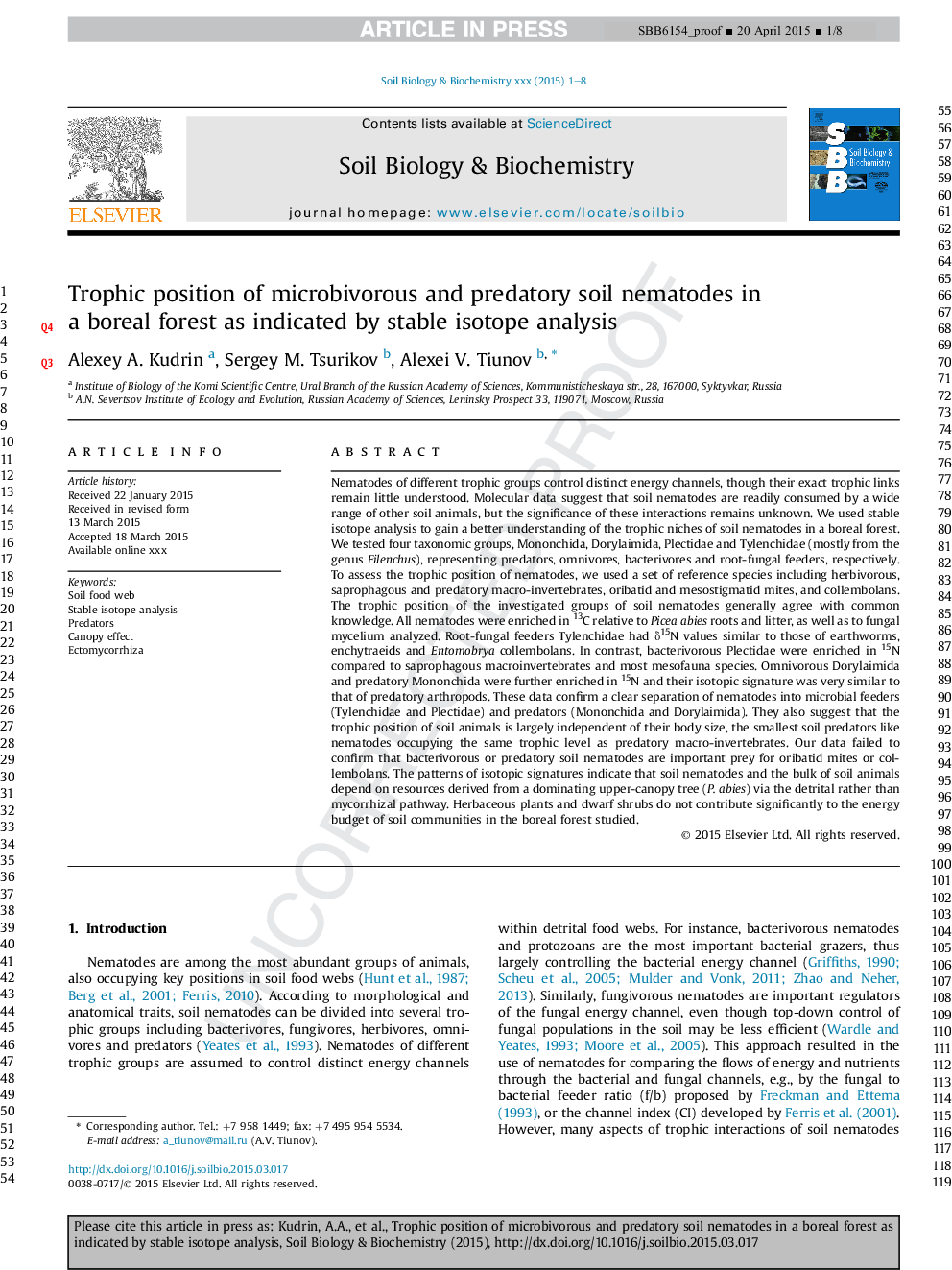| کد مقاله | کد نشریه | سال انتشار | مقاله انگلیسی | نسخه تمام متن |
|---|---|---|---|---|
| 2024535 | 1542598 | 2015 | 8 صفحه PDF | دانلود رایگان |
عنوان انگلیسی مقاله ISI
Trophic position of microbivorous and predatory soil nematodes in a boreal forest as indicated by stable isotope analysis
ترجمه فارسی عنوان
موقعیت جغرافیایی نماتدهای میکروبیولوژیک و گیاهخوار در جنگلهای بئوریک که نشان دهنده تجزیه و تحلیل ایزوتوپ پایدار است
دانلود مقاله + سفارش ترجمه
دانلود مقاله ISI انگلیسی
رایگان برای ایرانیان
کلمات کلیدی
موضوعات مرتبط
علوم زیستی و بیوفناوری
علوم کشاورزی و بیولوژیک
دانش خاک شناسی
چکیده انگلیسی
Nematodes of different trophic groups control distinct energy channels, though their exact trophic links remain little understood. Molecular data suggest that soil nematodes are readily consumed by a wide range of other soil animals, but the significance of these interactions remains unknown. We used stable isotope analysis to gain a better understanding of the trophic niches of soil nematodes in a boreal forest. We tested four taxonomic groups, Mononchida, Dorylaimida, Plectidae and Tylenchidae (mostly from the genus Filenchus), representing predators, omnivores, bacterivores and root-fungal feeders, respectively. To assess the trophic position of nematodes, we used a set of reference species including herbivorous, saprophagous and predatory macro-invertebrates, oribatid and mesostigmatid mites, and collembolans. The trophic positions of the investigated groups of soil nematodes generally agree with common knowledge. All nematodes were enriched in 13C relative to Picea abies roots and litter, as well as to fungal mycelium analyzed. Root-fungal feeders Tylenchidae had δ15N values similar to those of earthworms, enchytraeids and Entomobrya collembolans. In contrast, bacterivorous Plectidae were enriched in 15N compared to saprophagous macroinvertebrates and most mesofauna species. Omnivorous Dorylaimida and predatory Mononchida were further enriched in 15N and their isotopic signature was very similar to that of predatory arthropods. These data confirm a clear separation of nematodes into microbial feeders (Tylenchidae and Plectidae) and predators (Mononchida and Dorylaimida). They also suggest that the trophic position of soil animals is largely independent of their body size, the smallest soil predators like nematodes occupying the same trophic level as predatory macro-invertebrates. Our data failed to confirm that bacterivorous or predatory soil nematodes are important prey for oribatid mites or collembolans. The patterns of isotopic signatures indicate that soil nematodes and the bulk of soil animals depend on resources derived from a dominating upper-canopy tree (P. abies) via the detrital rather than mycorrhizal pathway. Herbaceous plants and dwarf shrubs do not contribute significantly to the energy budget of soil communities in the boreal forest studied.
ناشر
Database: Elsevier - ScienceDirect (ساینس دایرکت)
Journal: Soil Biology and Biochemistry - Volume 86, July 2015, Pages 193-200
Journal: Soil Biology and Biochemistry - Volume 86, July 2015, Pages 193-200
نویسندگان
Alexey A. Kudrin, Sergey M. Tsurikov, Alexei V. Tiunov,
